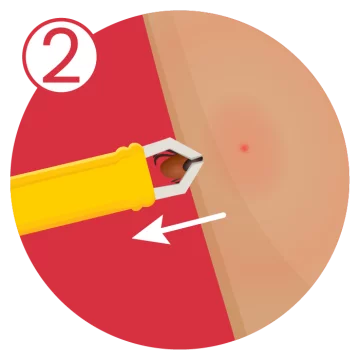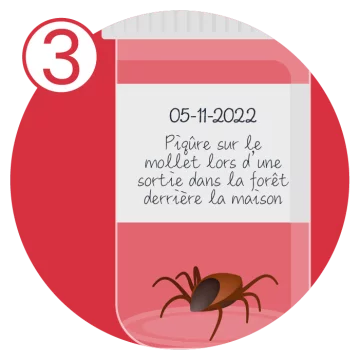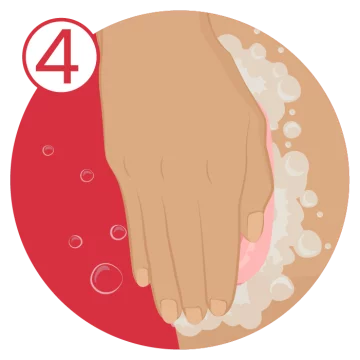may 20, 2022
What to know about ticks.
Are you an outdoor enthusiast or gardening enthusiast?
May is the perfect month to get back into the outdoors. However, Quebec spring also means the end of hibernation for the 12 species of ticks that live here. All it takes is an average temperature of at least 8 degrees for several days in a row for them, too, to resume their activities. (piqure-de-tique.ch, s.d.)
What ticks should you watch out for?
Not all ticks are dangerous. In Quebec, they are actually classified into the following five genera: Amblyomma, Dermacentor, Ixodes, Rhipicephalus and Haemaphysalis (INSPQ, n.d.(a)). The only one of these that is potentially harmful to health is the Ixodes genus, specifically the Ixodes scapularis tick, commonly known as the black-legged tick or the deer tick. It is considered a nuisance because it can transmit Lyme disease. (Gouvernement du Québec, 2022(a)).
Ixodes scapularis ticks
This family of insects has no wings or antennae. Blacklegged ticks have four pairs of legs which, as the name suggests, are black. The male's body is dark brown, almost black. The female has a black patch covering a reddish-brown abdomen (Villeneuve, 2012). When not gorged with blood, they vary in size from 0 to 5 millimeters, depending on their three stages of development: larva, nymph and adult. They can triple in volume when filled with blood (INSPQ, n.d.(b)).
It is important to note that blacklegged ticks are difficult to distinguish from other tick species. That's why, in the event of a bite, it's advisable to keep the tick in an airtight container. This way, if the condition declines in the following days or weeks, it will be easier to determine whether it was carrying the bacteria causing Lyme disease.
Where are they hiding?
Ticks hide in places with vegetation, such as:
- Forests;
- Woodlands;
- Tall grasses;
- Gardens;
- Landscaping;
- Leaf litter.
According to INSPQ monitoring data, the areas most at risk are:
- Northern and western Estrie ;
- A large part of the Montérégie region;
- Southwest Mauricie and Centre-du-Québec region;
- Southwestern Outaouais.
However, they are present in all but the most northerly regions of Quebec: Northern Quebec, Cree Territories and Nunavik. To follow the evolution of the risk of acquiring Lyme disease and find out which areas are at risk, click here.
Why do ticks attach themselves to our skin?
Ticks have three stages of development. They must feed on the blood of animals or humans to pass from one stage to the next. Their meal can last from 3 to 10 days, which means they will remain attached to your skin for that length of time if you don't remove them (INSPQ, n.d.(b)).
Will I feel it if a tick has latched onto me?
Probably not, since its bite is generally painless due to the anesthetic substance it secretes in its saliva. So, the only way to know if a tick has latched on to you is to inspect your body after every outing in a place where ticks can be found.
Ticks like to cling to moist areas rich in blood vessels. That's why it's important to check these areas of your body more carefully. For example, carefully inspect the back of your knees, the underside of your armpits and the back of your ears. (Buchner, 2021) When you look, you'll see his head buried in your skin and his body on the outside. What's more, if you take a bath or shower after your outings, inspection will be easier, and it could knock off any ticks that weren't already firmly attached.
How do I remove a tick?

Using fine forceps or a tick remover, grasp the tick as close as possible to your skin, taking care not to squeeze its abdomen.

If you're using fine tweezers, pull gently but firmly and steadily, without twisting or crushing to avoid breaking the tick.
If using a tick puller, follow the manufacturer's instructions.
If the tick head remains embedded in the skin, you can remove it with the pliers.
If you can't, leave the head in place and let the skin heal.

Once you've removed the tick, store it in an airtight container in the fridge and make a note of the part of the body and place where you were bitten, and the date the tick was removed.
This could be useful if your condition worsens and you need to see a doctor.

Clean your skin with soap and water, then wash your hands.
It is important to consult a physician if :
- After being bitten by a tick, you develop redness measuring 5 cm in diameter or more.
- After being bitten by a tick, redness persists for more than 48 hours.
- In the weeks or months following an outdoor activity that could expose you to ticks, you present one or more symptoms of Lyme disease.
Don't hesitate to call Info-Santé if you've been bitten in a high-risk area.
A little information about Lyme disease
The symptoms
The first signs of the disease generally appear between 3 and 30 days after the bite of a tick carrying the bacteria. Of course, symptoms vary from person to person, but the most common symptom is a painless reddening of the skin around the bite, which lasts for at least 48 hours and reaches around 5 centimetres. The following symptoms may also be experienced:
- Fatigue
- Fever
- stiffness
If not diagnosed and treated quickly enough, the following symptoms may appear in the weeks and months following the bite:
- Appearance of several spreading red spots on the skin, with little or no pain or itching.
- Facial paralysis, numbness of limbs, neck pain, severe headaches.
- Joint inflammation and pain.
- Chest pain, palpitations or dizziness.
Treatment
Lyme disease is treated with antibiotics prescribed by a physician. The nature and duration of treatment depend on the stage of infection and the symptoms present. In general, treatment leads to rapid and complete recovery from the disease. However, in some treated individuals, symptoms may persist for several months (Gouvernement du Québec, 2022(a)).
Transmission
After being bitten by an infected tick, if it remains attached to the skin for less than 24 hours, the risk of developing the disease is very low. However, this risk increases if the tick remains attached for longer (Gouvernement du Québec, 2022(a)).
How can I avoid being bitten by a tick?
Ticks don't jump, fly or drop from a high surface (e.g. a branch). They can, however, hide in plants and cling to you as you walk by. (Government of Quebec, 2022(a))
Physical actions
Walk on well-trodden paths and avoid walking in tall grass.
Use insect repellent (DEET) on exposed parts of your body (except the face).
Wear a hat, closed shoes and long clothing.
Tuck your sweater into your pants and the bottom of your pants into your socks.
Wear light-colored clothing when walking (they don't keep them away, but make them more visible on your clothes).
Environmental actions
Cut tall grass and brush around your home, and mow your lawn.
Remove dead leaves and weeds from lawns, wood stores and sheds.
Create wood chip or gravel paths between wooded areas and lawns, patios and play areas.
Set up play areas away from trees, in a sunny spot.
Stack wood carefully, sheltered and dry (this can keep rodents away, which attract ticks).
Actions on arriving home
Examine your equipment when you return from an outdoor activity (e.g. backpack).
Examine your pets' skin after outdoor activities.
Eliminate ticks on your clothes by putting them in the dryer at high temperature for 10 minutes. If clothes are too dirty to be put in the dryer directly, machine-wash them in hot water, ideally for at least 40 minutes. Then tumble dry on high for at least 60 minutes (garments must be completely dry).
Article written by Laurie Levesque.
Edited and formatted by Emilie Bedard.